Service Reservoir Isolation Programme (2021)
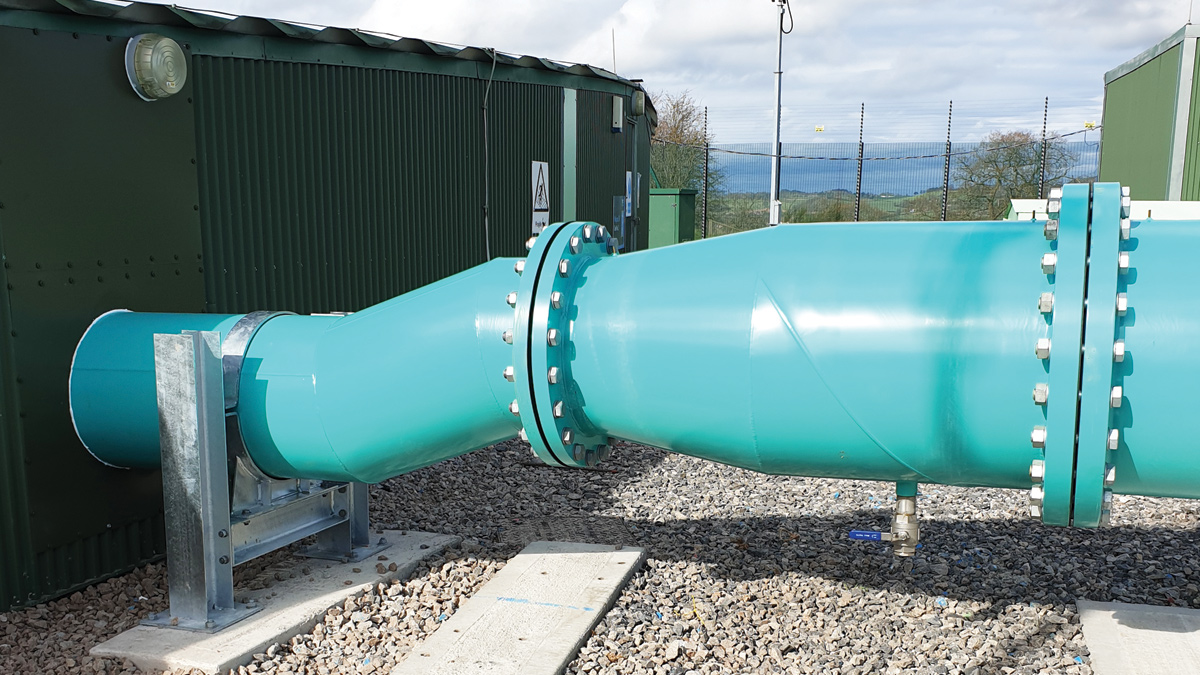
Pipework at Malpas Service Reservoir - Courtesy of MMB
In 2016, United Utilities was issued with a Service Reservoir Cleaning notice by the Drinking Water Inspectorate (DWI) as part of the Company transformation programme. Inspecting, cleaning and maintaining the reservoirs first required a batch of projects to provide the facility to isolate five existing service reservoirs (SRs) from the water network, whilst maintaining supply to customers. The first notice was issued on 6 October 2016 with an initial completion date for all the reservoirs by the end of September 2020, but was later re-negotiated to June 2022 to allow for the impacts of unforeseen and unexpected situations such as prolonged dry weather periods and the major disruption due to Covid-19. In addition, following the experience gained through the initial phase of the inspection programme additional time was allowed for the tanks to be inspected and remedial works carried out. The batch of projects was designed and constructed by Mott MacDonald Bentley (MMB), as part of the United Utilities’ AMP6 framework Construction Delivery Partnership contract.
Background
Following issue of this notice from the DWI, investigations were undertaken across the region and tanks that could not be isolated were identified by United Utilities Network Operations teams. Originally 35 (No.) tanks were raised as a risk, however as the programme has progressed, additional sites have been identified.
Five sites were specifically identified as requiring significant capital investment to provide the infrastructure and control required to enable the existing SRs to be taken out of service for inspection and maintenance whilst maintaining wholesome water supply for customers and operational resilience. Although these sites were geographically spread around the United Utilities region, and the solutions were likely to vary significantly across the five individual projects, it was assessed that there would be delivery efficiencies in batching these sites together and contracting with a single delivery partner.
Service Reservoir Isolation Programme: Supply chain – key participants
- Main contractor: MMB
- Under pressure pipework connections: Power Technology Services (PTS)
- Electrical installation: Eric Wright Water
- Electrical installation: Boulting Ltd
- Control panel supply & installation: Lloyd Morris Electrical Ltd
- Systems integration: Tata Control Systems
- Systems integration: Cougar Automation
- Pipework fabrication & installation: Powerrun Pipe-Mech
- Metalwork fabrication & installation: Fabtek
- FRC construction for new SR: Absolute Formwork
- Security fencing to new assets: Burn Fencing
- Supply of precast elements for SR roof construction: Stresslite Precast
- Supply and testing of intelligent membrane for SR roof: Sensor UK
- Pressure management valves: Bermad
- Pressure management valves: Cla-Val
- Stakkabox chambers: Cubis Systems
- Security products: Technocover
- Chlorination & testing: Panton McLeod
Early works
Following initial business case reviews within United Utilities, the projects were issued to the Capital Delivery team at the start of 2018. The outline solutions were reviewed jointly with the United Utilities client, operational representatives and key engineering discipline leads to confirm the feasibility of the concept solutions. MMB were then engaged in summer 2018 to assist with this early solution confirmation, undertaking both further outline design and intrusive site investigations to develop the solutions, mitigate key risks and be able to produce and agree a target cost.
Within the jointly-developed works information documents, specific solutions were not defined so as to still allow flexibility for innovation to drive cost-effective delivery when in contract. A single NEC ECC Option C contract was awarded for all five sites.
Further information on the works required at the five individual sites is given below.
Warbreck Tower
Warbreck Tower is an existing water tower in Blackpool, supplying potable water to approximately 46,000 properties across two water supply zones. The tower is a single compartment, with a capacity of approximately 2.73Ml. The tower is on the same site as an existing below-ground service reservoir. Under normal operation, the tower is fed by gravity from the upstream Barnacre Service Reservoir.
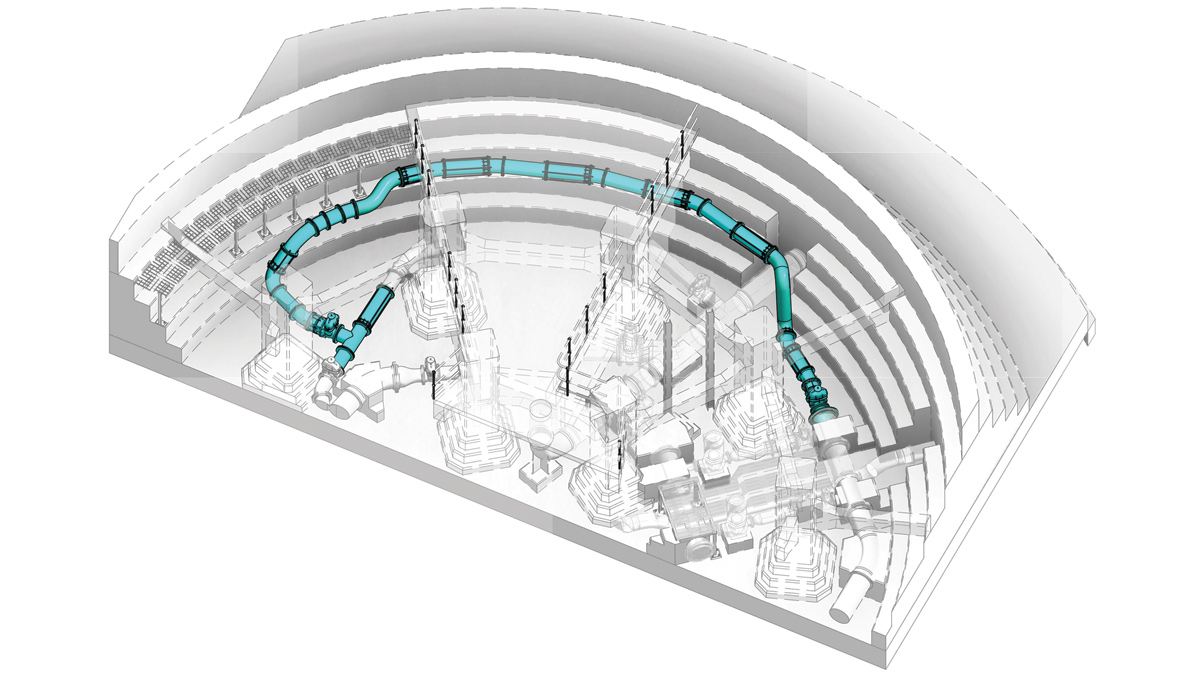
Isometric drawing of pipework within the tower basement – Courtesy of MMB
In periods of low demand, water from the tower overflows and fills the adjacent service reservoir. When demand is higher, pumps within the tower basement re-fill the tower with stored water from the service reservoir from where it gravitates into supply.
The original proposed solution was to provide a new pumping station adjacent to the water tower, to pump water from the service reservoir directly into supply. This would be controlled to achieve the required pressure in the network. Because of the variation in flow through the day and night, a bypass pipe was required, with pressure sustaining valves, to direct excess flow back towards the reservoir in periods of low demand and prevent over-pressurising the network.
During initial investigations, multiple buried services were located that impacted on the location and constructability of the new proposed pumping station. Concurrently, additional studies were undertaken on the existing pumps within the tower basement. This concluded that if the pump control was modified, these pumps could operate as variable speed and would be adequately sized to meet the peak network demand. However, significant pipework modifications would be needed within the basement to facilitate the required connections and space and access were limited.
A laser scan survey was carried out and the detail of the installed equipment in the basement was 3D modelled in Revit. Pipe routes and connections were then designed around this. Virtual and on-site access reviews were held to ensure that the proposed pipes and equipment were accessible, maintainable and constructable and existing access points were modified to suit.
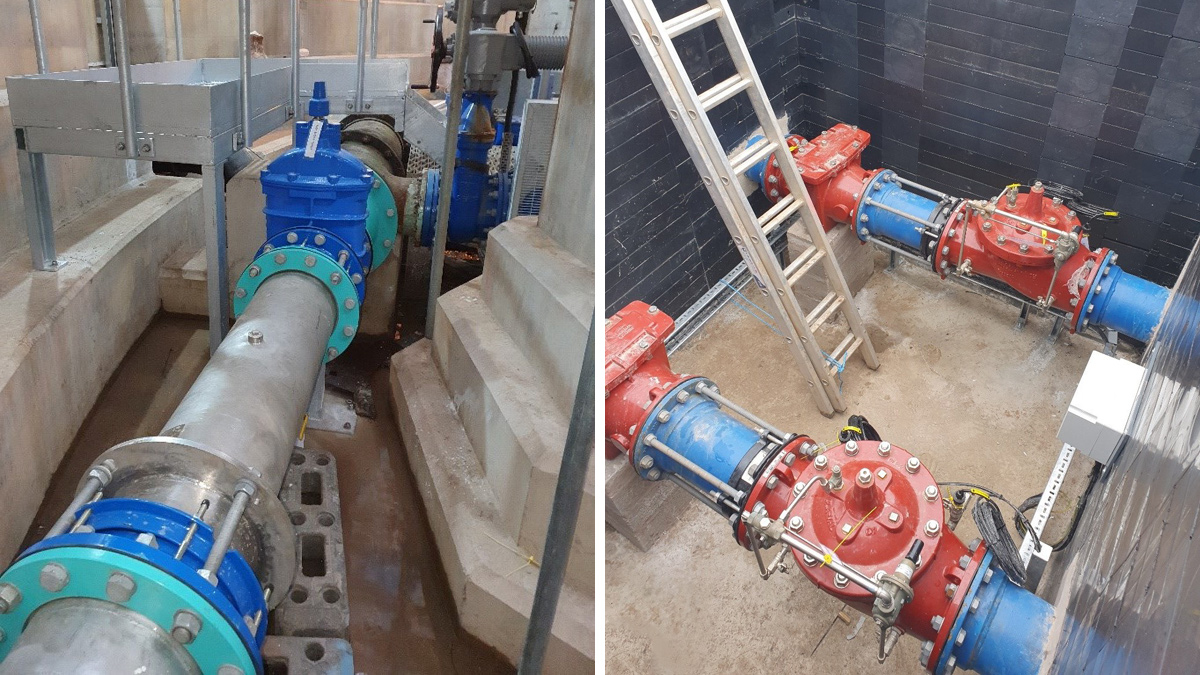
(left) New basement connecting pipework and access platforms and (right) new pressure sustaining valves, designed and supplied by Cla-Val – Courtesy of MMB
The existing pumps were inspected and serviced, and changed to variable speed control to be based on a pressure set-point, designed from the network model. Although four pumps were installed, in the tower isolation configuration only three (operating duty/assist/standby) were required to meet the peak network demand. A detailed surge analysis was undertaken to ensure no risk to the network in the event of pump failure; this was also used to optimise the running configuration of the duty and assist pumps to minimise risk to supply and the installed equipment.
Winwick Service Reservoir
Located near Newton-le-Willows, just to the north of Warrington, Winwick Service Reservoir with a storage capacity of 18Ml supplies approximately 26,000 properties. The service reservoir is located at the site of Winwick WTW, which treats water extracted from three borehole sites via a combination of Amazon filters, UV treatment and a membrane plant. As well as storing water for supply, the service reservoir also acts as a blending tank for the multiple water sources. Isolating the service reservoir also requires these boreholes to be isolated because of this loss of storage, blending and contact time and therefore an alternative supply source was need to allow the reservoir is to be bypassed. Flows from Winwick SR are distributed north and south from the site via separate pumping stations.
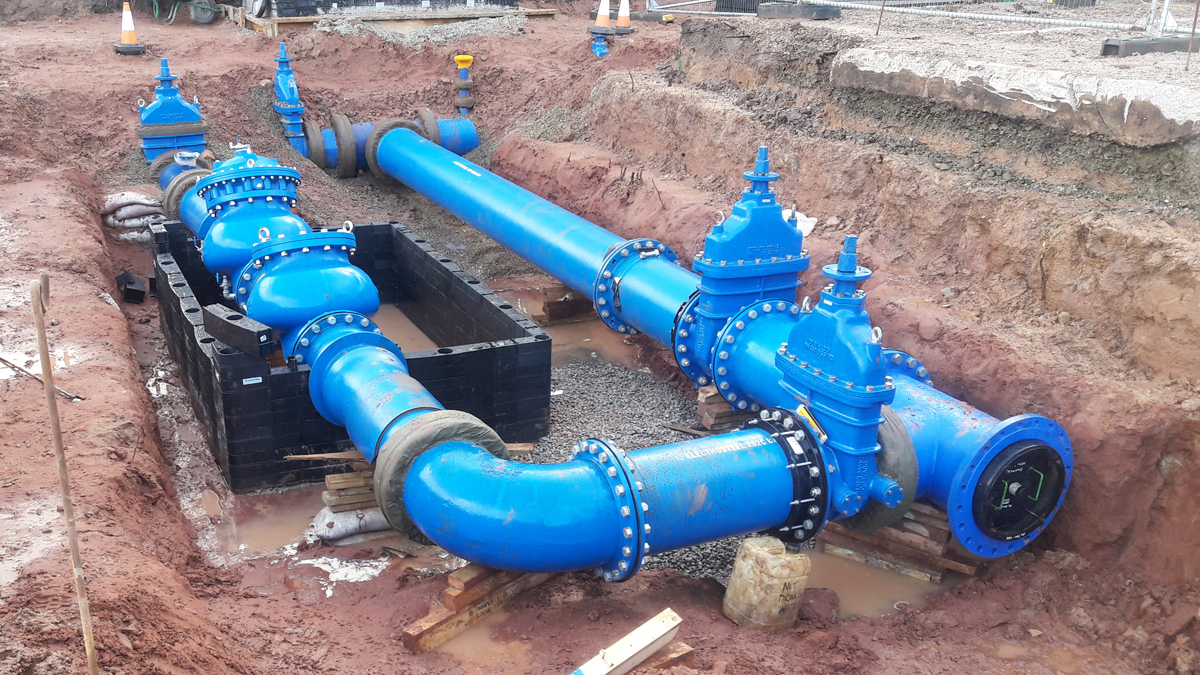
PRV installation and pipework construction at Rob Lane – Courtesy of MMB
Following feasibility reviews, the preferred solution was identified as making connections to allow the site to be fed using water from United Utilities’ West-East Link Main (WELM). The WELM is a strategic asset connecting treatment and storage sites in Merseyside to Greater Manchester, allowing linkage between the key supply and demand areas within the region. The WELM is a bi-directional main, so supply can be fed either from the west or the east based on planned or emergency production and maintenance scenarios.
When the WELM was constructed a valved, blank tee connection was included adjacent to a disused secondary disinfection site at Rob Lane, at the northern extent of the Winwick supply zone, approximately 6km from the WTW site. The solution required a new connection pipeline from this pre-installed tee connection, into an existing 21” main which runs from the Winwick WTW site up to Rob Lane. Flows in this main were then to be reversed, with flow taken off from the WELM transferring from north to south and feeding all off-takes along the line before reaching the WTW and SR site.
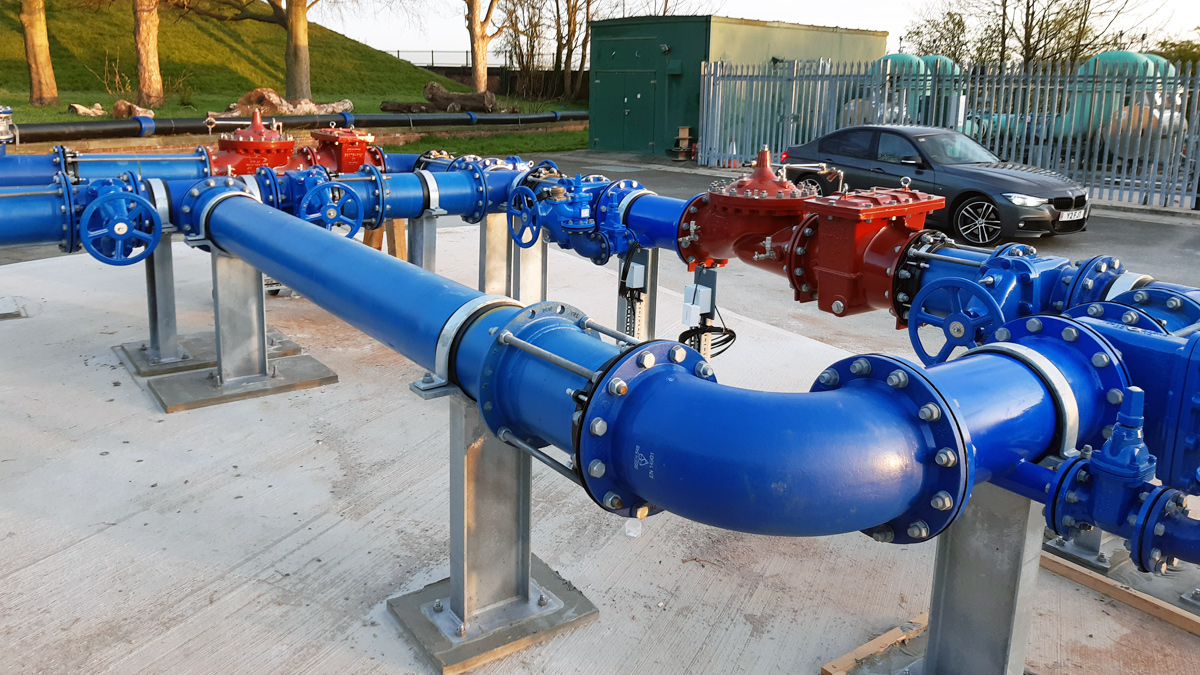
New PRV installation at Winwick SR – Courtesy of MMB
Within the site, additional cross-connecting pipework was installed so water within the 21” main could be connected into the feed pipework and pumping stations to the southern DMAs. PODDS (Prediction and Control of Discolouration in Distribution Systems) modelling was undertaken to assist with planning of a flushing and conditioning exercise for the reversal of the 21” main to the north of Winwick.
At the Rob Lane site, new pressure management valves (PMVs) were required to ensure that the pressure was managed and did not significantly exceed the current maximum within this area so not to increase the risk of bursts or leakage. The PMVs, designed and supplied by Bermad, were controlled based on a timed setting to account for the reduced demand overnight and hence further restrict the pressure at these times. The pipework and PMVs were installed below ground, with ‘Stakkabox’ chambers constructed around the valves, and Technocovers installed for security.
To manage the change in water supply and the impact on customers, temporary chemical dosing for both pH correction and chlorine is also introduced at the Rob Lane site when the SR isolation system is in use, with phosphate dosing also added.
The existing control and monitoring system for the WELM includes a leak detection function to identify when flows vary along the length; this had to be modified to allow for the new Rob Lane take-off along with the flow control settings of the WELM to allow for the variable demand from the new Winwick supply.
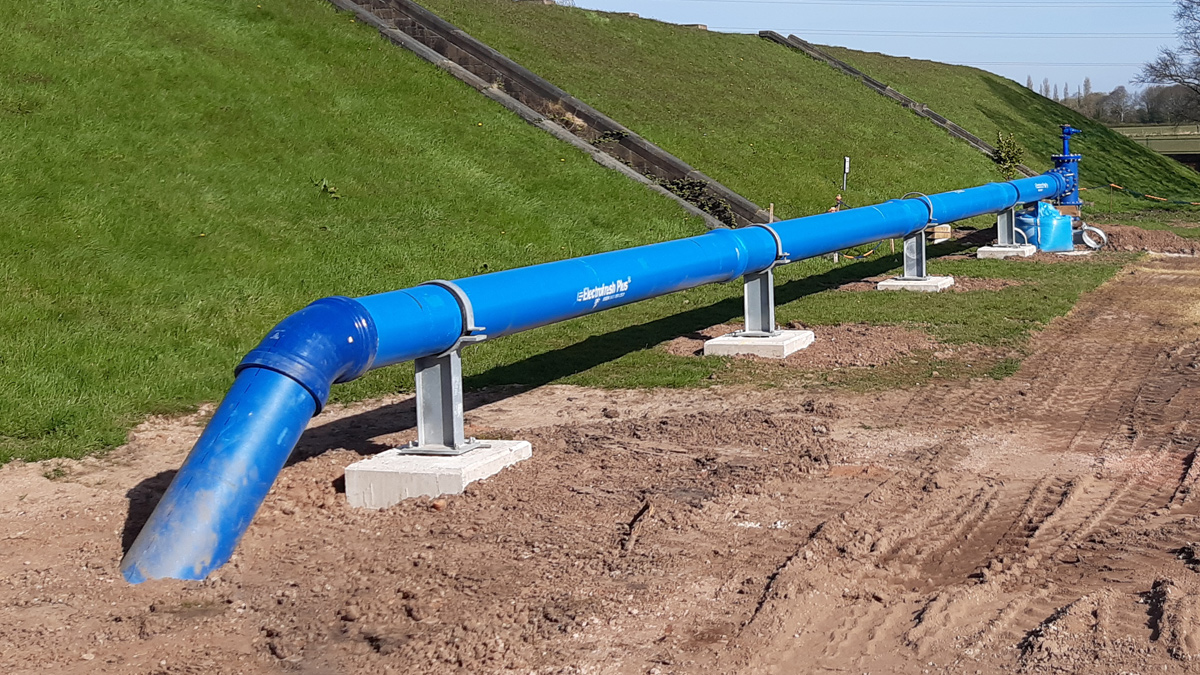
New service reservoir bypass pipework at Winwick SR – Courtesy of MMB
Within the Winwick WTW site, additional PMVs were installed to further reduce the pressure to match that of the service reservoir when in operation prior to onward distribution to the southern zones normally fed from the site. These PMVs were designed and supplied by Cla-Val; a different supplier was chosen from the Rob Lane site to achieve the optimal sizing based on the flow and pressure requirements.
Gorsehill Service Reservoir
The Gorsehill site consists of five service reservoirs and a blending tank. The site is located in Ormskirk, Lancashire, and supplies just over 200,000 properties across six supply zones. The site was previously fed from four separate borehole sites, with all inflows mixing in the blending tank before being distributed between the service reservoirs. A recent upgrade project had facilitated the abandonment of these borehole sites by the construction of a new WTW at Royal Oak, with a single pumped supply to the Gorsehill SR site. With the inter-connectivity in the wider United Utilities water network, the site can also be fed from the Liverpool trunk main in an emergency or maintenance scenario. The outlets from all of the reservoirs combine within the site before separate outlet pipework to each of the discrete supply zones.
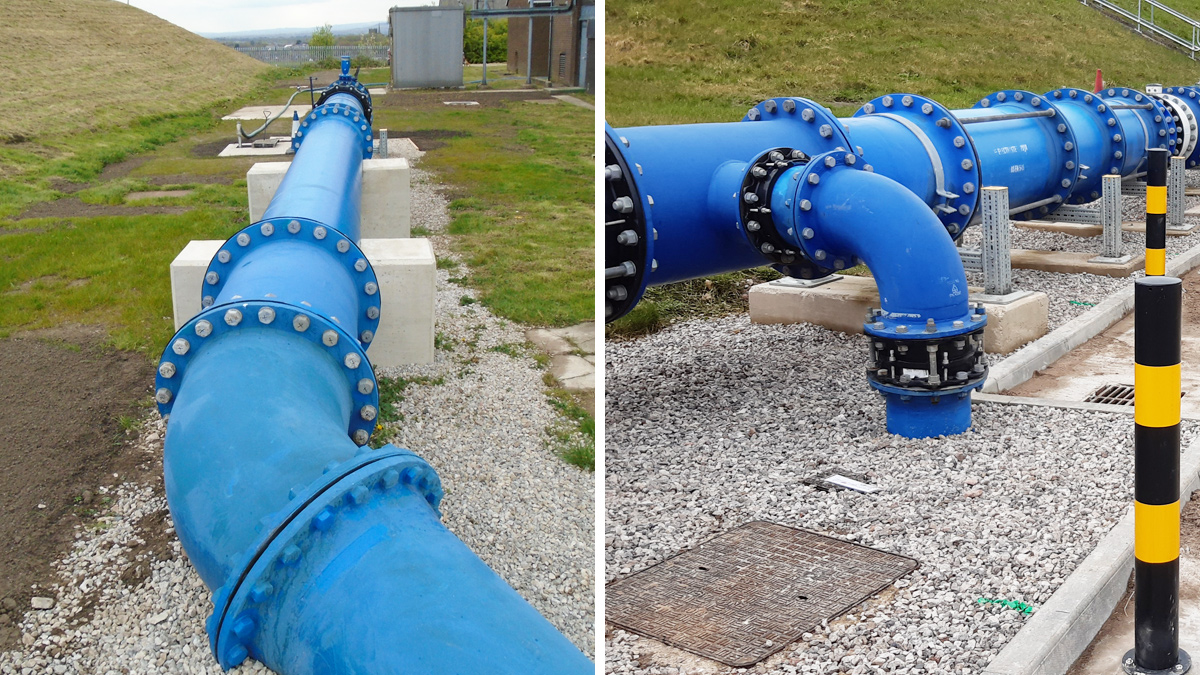
New connection pipework at Gorsehill Service Reservoir – Courtesy of MMB
Of the service reservoirs on the site, SR1 has previously been abandoned. SR2 and SR3 both have existing bypass facilities and can be isolated without detriment to supply. The requirement of the project was therefore to provide facility to isolate SR4 and SR5, as well as the blending tank. The tanks are not required to be isolated concurrently so each reservoir (including the blending tank) is isolated in turn with all other tanks in service at that time. SR4 and SR5 are connected by a single dividing wall with a penstock that is permanently in the open position, effectively leading to the twin tanks acting as a single reservoir.
Hydraulic network modelling established that, subject to the control on the inlet pumps from the new WTW site, each of the service reservoirs in turn could be isolated from service indefinitely for inspection and maintenance and still retain capacity to feed the required supply zones. However, the pipework connectivity did not allow either the blending tank or SR4 and SR5 to be isolated. The proposed solution therefore required the site inlet flows to be combined and a new ‘header’ main constructed to distribute flow between the in-service reservoirs without passing through the blending tank.
A desktop study of existing site drawings, combined with GPR and trial holes, showed that there was an extensive network of below-ground services around the site and in particular in the vicinity of the blending tank. Although for both security and hydraulic design it was considered preferable to locate the new header main below ground, this would have been a high-risk solution and would have required multiple low and high points to cross existing services. The design was developed to include for this header main to be constructed above ground. Fittings such as air valves were selected to be suitable for low-head sealing, and the arrangement allowed the pipework to be positively isolated from the network when not in use to mitigate the potential risk of ingress or contamination.
The inlet pumps from the new Royal Oak WTW site are currently controlled from the level in the blending tank. Modifications were made to this control to allow the level control to be switched to the SR4/5 level instrument for when the blending tank is out of service.
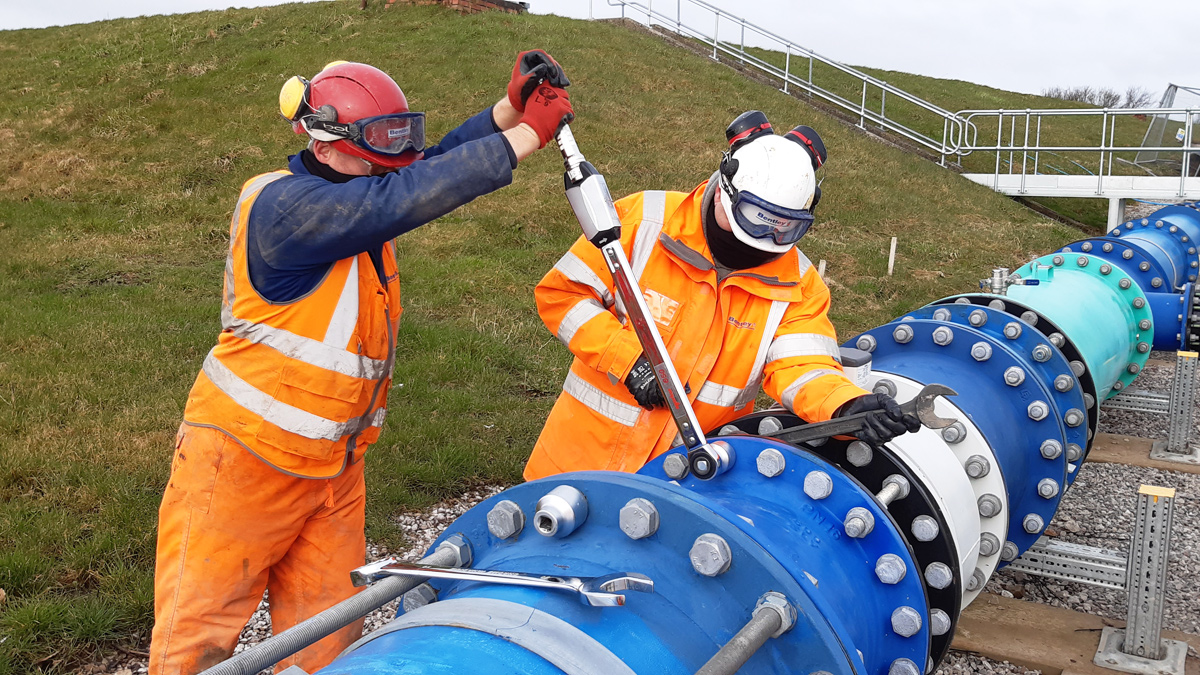
New connection pipework at Gorsehill Service Reservoir – Courtesy of MMB
Malpas Service Reservoir No. 1
Malpas SR No. 1 is located in the Vyrnwy aqueducts in Cheshire. The aqueducts transfer water from Lake Vyrnwy, via Oswestry WTW, to Liverpool and Merseyside from where it can also link with the Manchester ring main and other regional transfer mains. Malpas SR No. 1 has a capacity of approximately 1.2 Ml and acts as a balancing tank between the three lines of the aqueduct.
There is a second service reservoir, Malpas No. 2, on the same site however the outlet from this returns to SR No.1 rather than directly into the aqueduct pipelines. The Vyrnwy Aqueducts have a modelled minimum flow of 105 Ml/d and a maximum design flow of 360Ml/d. The reservoir has an existing bypass pipe, however this is only connected from Line 3 of the aqueduct.
Line 1 of the Vyrnwy aqueduct started construction in 1881 and was fully complete and brought into service in 1892. The pipeline is 42” cast iron. Line 2 is also 42” cast iron and was constructed between 1902 to 1905. Malpas SR No. 1 was constructed at this time, to act as a balancing tank between the aqueducts. The third line of the aqueduct, this time constructed from bitumen-lined steel at 39” diameter, was started in 1926 and opened in 1938, including a new tunnel crossing beneath the River Mersey and the Manchester Ship Canal.
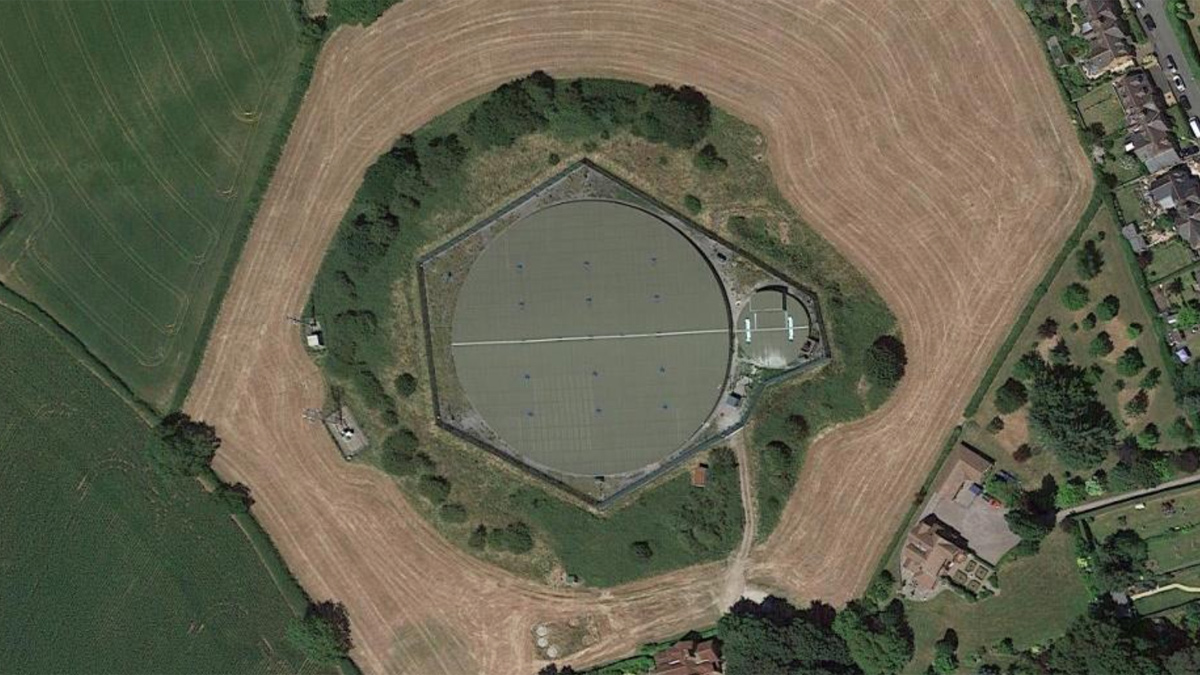
Google Maps view of Malpas SR No.1 and SR No.2 – Courtesy of MMB
During the initial investigation and conceptual design phase, the design flow for the bypass scenario was challenged and discussed at length within the production planning teams. After modelling many scenarios and considering the age and condition of the service reservoir to assess the most likely timescales that the tank would need to be out of service for maintenance, it was agreed that the design could be based on the lower flow range of 110 Ml/d, which gave a significant cost reduction compared with designing for the maximum flow of 360 Ml/d.
Modelling reviews and hydraulic assessments concluded that the existing bypass pipe around SR No. 1 had sufficient capacity to facilitate the required output from Oswestry WTW of 110 Ml/d with no additional bypass pipework required. However, due to the impact if Line 3 of the aqueduct failed in the 6km length between the next crossover valve chambers, it was a requirement that all three lines were to be cross-connected instead of just operating from Line 3. Lines 1 and 2 of the aqueduct could then be isolated using existing line valves upstream and downstream of the service reservoir, with flows from all three lines being transferred via the new proposed cross-connections into the existing Line 3 bypass.
A minimum of two lines of the aqueduct were required to be kept in service at all times throughout construction and commissioning. MMB and United Utilities worked together with the supply chain to develop a methodology for the cross connections that minimised the impact on supply and resource usage by reducing time periods for outages, whilst also not increasing risk to the existing infrastructure during the works. Working with specialist under pressure drilling subcontractor, Power Technology Services (PTS), a proposal was developed to drill under pressure tees into the top of each of the three lines, with then a manifold cross-connection installed between all three.
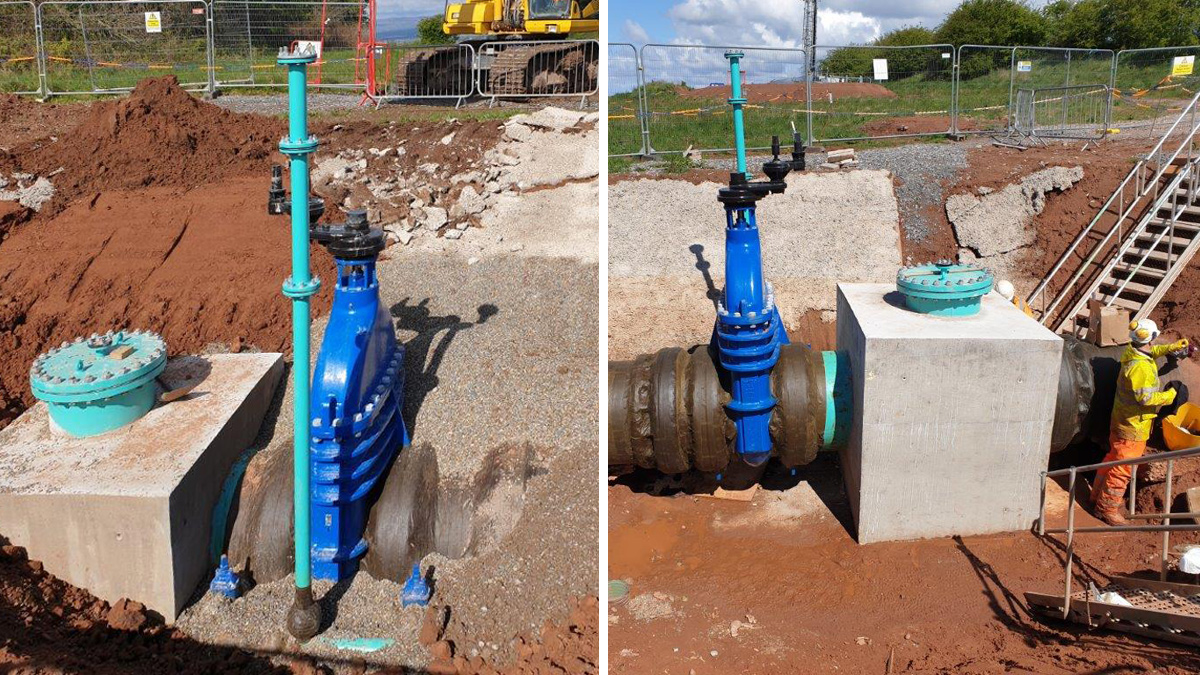
Valve installation downstream (left) and upstream (right) at Malpas SR – Courtesy of MMB
Detailed inspections and non-destructive testing of each line were carried out to prove the integrity prior to drilling the connections. The underpressure tees were 600mm diameter, then tapering up to 900mm for the manifold connections. Isolation valves and drain points were added at either end of the existing bypass main. There was an existing pressure relief pipe that allowed the bypass line to vent, discharging into SR No. 1. This was also extended to discharge into SR No. 2 instead, ensuring that SR No.1 was fully isolated and could not become inundated during inspection or maintenance works.
Kerridge Service Reservoir
Kerridge Service Reservoir is a single compartment, 4.5Ml tank located on the edge of the Peak District National Park, supplying approximately 7,000 properties. The reservoir receives pumped flows from Lamaload WTW. The SR also has a bypass main which can be used to back-feed additional service reservoirs and areas during outages of Lamaload WTW of up to 12 hours.
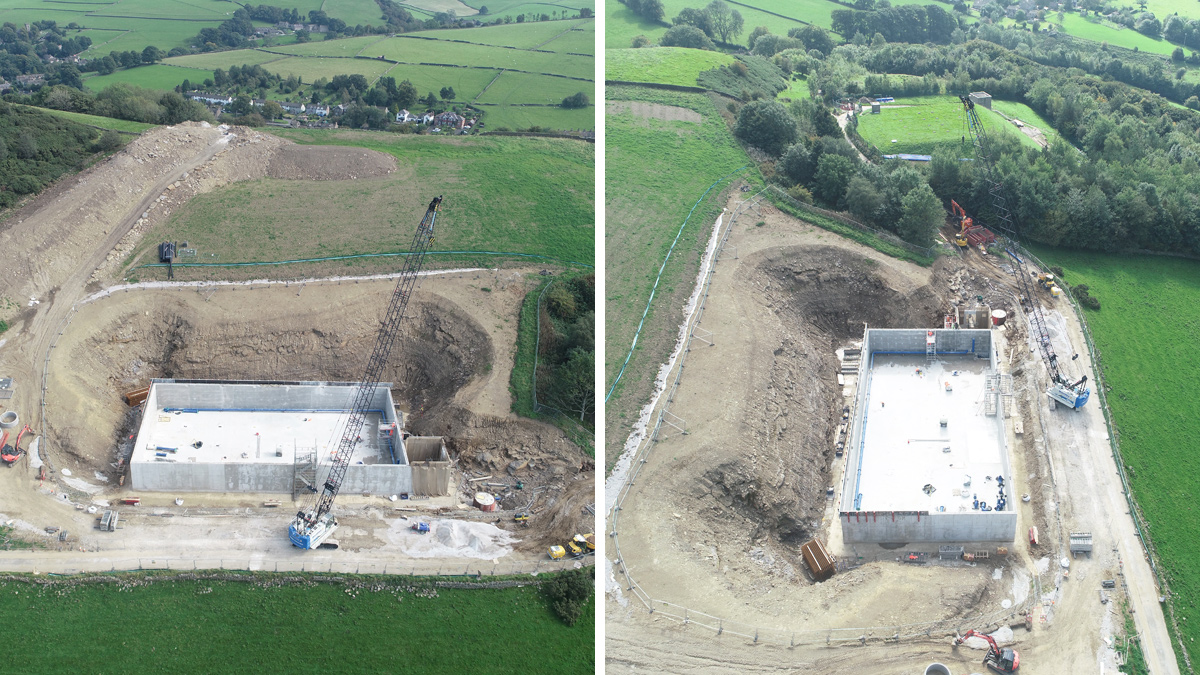
Tank construction at Kerridge Service Reservoir – Courtesy of MMB
Early investigations and feasibility considered several options for maintaining supply with the reservoir isolated. These included utilising existing assets and configurations, constructing a new pumping station at an alternative WTW in the area to backfeed the areas fed from Kerridge, and building an additional reservoir compartment at the Kerridge site to maintain supply. Utilising existing configurations was discounted as an option because of the risks to supply, particularly in the event of an outage at Lamaload WTW. Alternative pumped supplies were also ruled out because of the complexity and extent of the modifications and pipework which, based on initial estimates, would not have been a cost effective solution. The agreed preferred solution was therefore to build an additional compartment for the service reservoir at the Kerridge site, sized to maintain supply whilst the original compartment was taken out of service for inspection and maintenance.
The existing Kerridge SR was constructed in the early 1960s. When constructed, the tank was ‘future-proofed’ by including tees and stub walls at one side of the single compartment, for the future addition of a second segment. Extending the reservoir by building on to this was initially considered as the primary option. However, after further surveys and consideration this option was ruled out. The adjacent land slopes away from the service reservoir at a gradient of approximately 1:3 so would have been challenging for construction and would also have led to the risk of differential settlement because of the increasing amount of in-fill material required to build up to the same founding level across the full width of the tank.
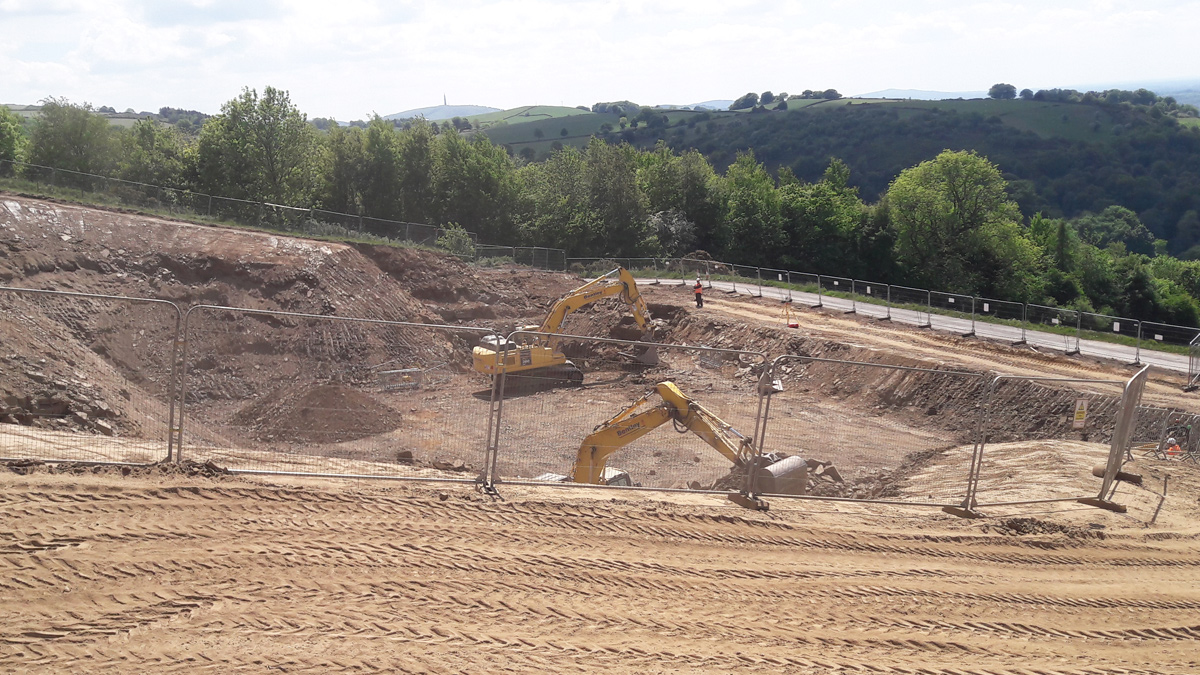
Excavation for new Kerridge Service Reservoir – Courtesy of MMB
The existing reservoir is founded on sandstone, so although this would have given a solid footing at the connection location, any excavation within this sandstone for construction immediately adjacent would have been risked causing vibration and potentially lead to damage to the existing compartment. The age of the reservoir also gave concern if using the existing end wall as a future dividing wall, considering the asset life of this section. It was therefore agreed that the preferred option would be to construct the second ‘compartment’ slightly away from the original tank.
For the hydraulic design of the system, the second compartment was required to have the same top and bottom water levels as the first to allow the tanks to operate in parallel for the majority of the time, when both are in service. Considering the hillside location, this was therefore the critical factor in siting the new tank. It was agreed as part of the pre-planning discussions that the new reservoir should be sited in a location that would require it to be dug in to the existing hillside, but would then allow the finished structure to be landscaped in to the natural topography.
To achieve these conditions, the new tank was constructed in a field approximately 150m away from the original reservoir, following agreement of land purchase and planning permission. Interconnecting pipework was laid between the two tanks for inlet, outlet to supply, overflow and scour. Because of the challenging site access, a road closure for the duration of the construction was agreed with the local authority as part of the planning consent.
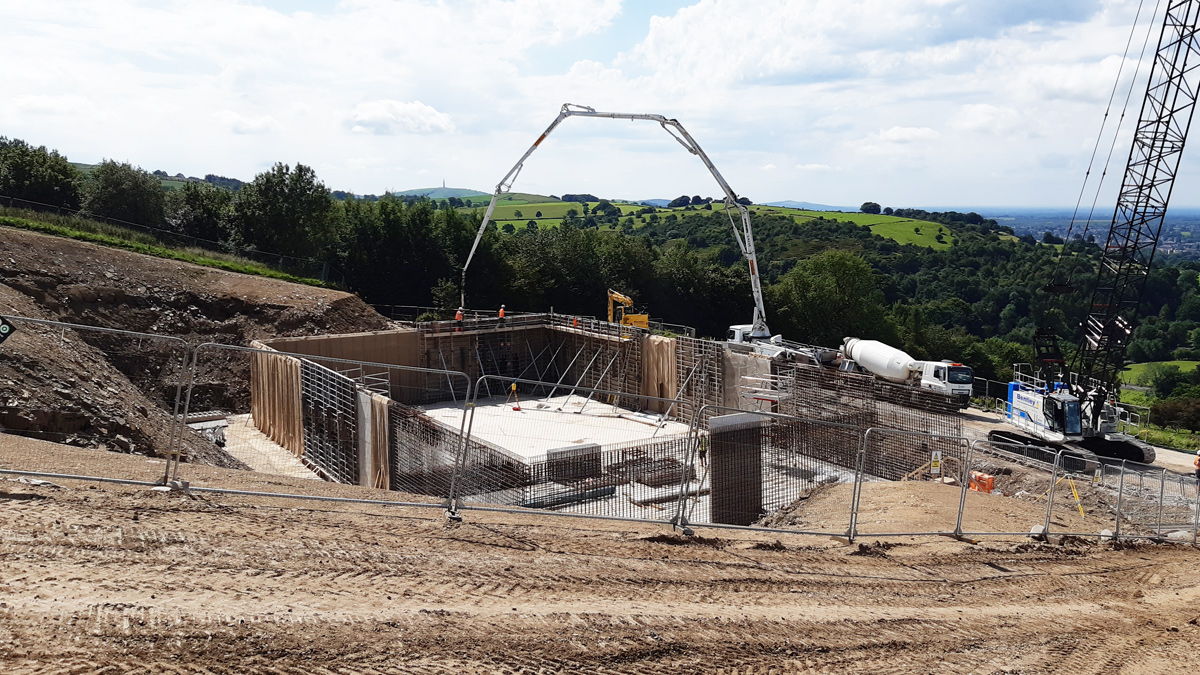
Tank construction at Kerridge Service Reservoir – Courtesy of MMB
For construction of the new reservoir, with the steeply sloping topography a bulk excavation was required of approximately 15,000m3, largely through weathered sandstone. The new SR base and walls were constructed from reinforced concrete; although precast was considered the narrow access roads and delivery restrictions meant that this was not a cost-effective solution.
However, the roof structure was constructed from precast concrete planks, overlaid with an in situ screed, and supported by precast beams spanning between columns in the reservoir. Precast elements were supplier by Stresslite.
Following the flood test, an intelligent membrane, supplied by Sensor UK, was then placed over the roof for additional protection against future ingress. The membrane has a conductive fleece, so if any damage occurs within the membrane itself a signal is sent to the control system to pinpoint the location so repairs can be made. Any exposed walls of the reservoir and valve house that would be visible from the surrounding area were clad with local stone.
The tank was constructed with an integral valve house containing the inlet, outlet, overflow and scour pipework including valves and drain facilities as well as a regulatory sampling point. A control panel was also included to power and operate the building services, level and flow instrumentation and security systems. The level control interfaces with Lamaload WTW, replicating the control from the existing SR when that is out of service.
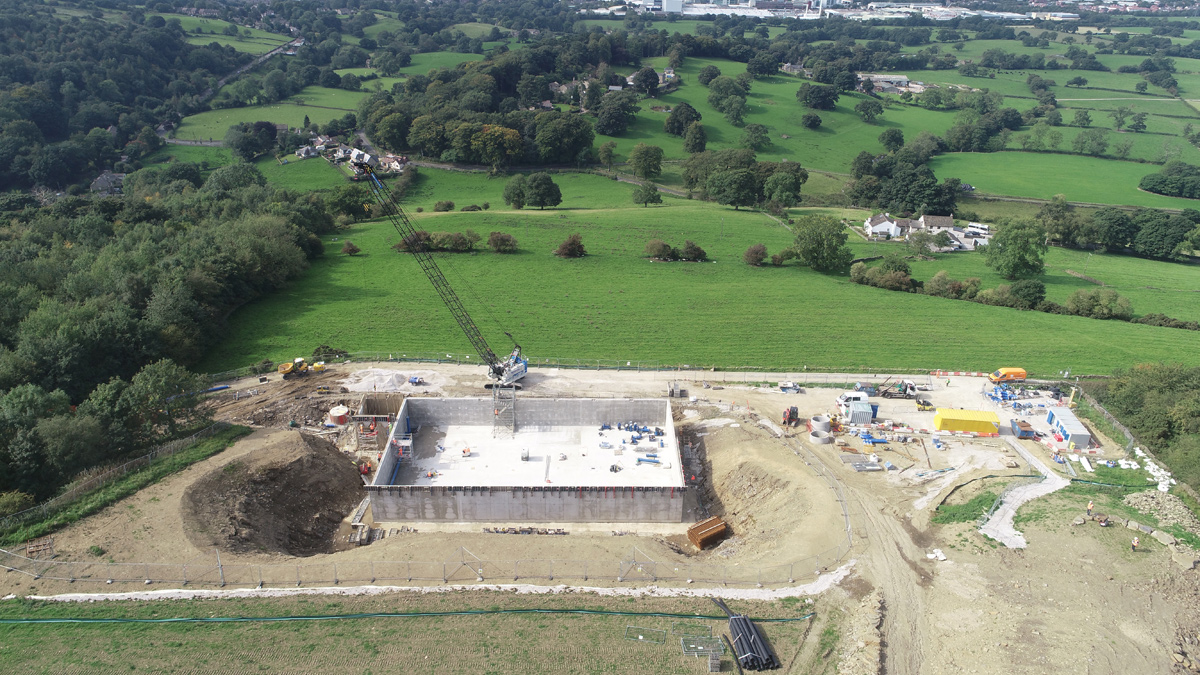
Tank construction at Kerridge Service Reservoir – Courtesy of MMB
Service reservoir isolation summary/conclusion
- Warbreck SR was the first site to be completed with the pumps and pressure control system calibrated and tested in February 2020.
- Gorsehill SR was completed in summer 2020 with final commissioning in June 2021 following interlinked works on another project.
- Construction of Kerridge SR was completed in winter 2020, with pipework and connections completed in spring 2021. It is due to be commissioned and put into supply in the summer of 2021.
- Winwick SR was completed in the summer of 2020 and will be fully commissioned by March 2022 following a mains cleaning programme in the area during 2021.
- Malpas SR was completed and commissioned in March 2020 with its first full outage and inspection due in 2022. The project also won ‘Utility Project of the Year’ at the Pipeline Industry Guild awards in 2020 due to the complex and innovative solution.
The ability to remove these reservoirs from service and maintain supplies in the area now means that all the service reservoirs will be added to a cyclic programme for inspection and cleaning in the future.






